As an Amazon Associate I earn from qualifying purchases.
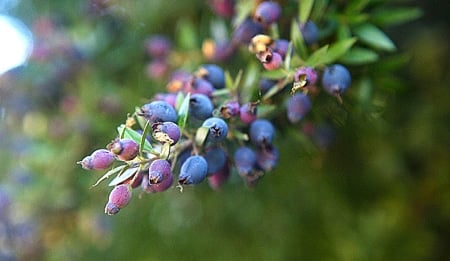
I’d never even heard of mirto until I read Efisio Harris’ Sweet Myrtle and Bitter Honey, which, to my mind, is the best English-language cookbook covering Sardinia — one of my favorite cuisines of Italy. Mirto is a heavy, sweet and herbal liqueur drunk all over Sardinia, at all occasions, much the way ouzo or raki is served in Greece.
With this description, I knew I had to have it. And I finally got my chance at the James Beard Awards in 2010, when I saw it on the menu at Craft, Chef Tom Colicchio’s flagship restaurant. When I took a sip, the liqueur tasted like a combination of gin and Fernet-Branca, another Italian digestif: Resinous, herbal, a little syrupy but very warming, very happy.
So what’s in mirto? Apparently, not much beyond myrtle berries and either honey or syrup. Huh. I can do that. It isn’t too different from my elderberry liqueur, only with myrtle berries. But how would I find this mystical plant?
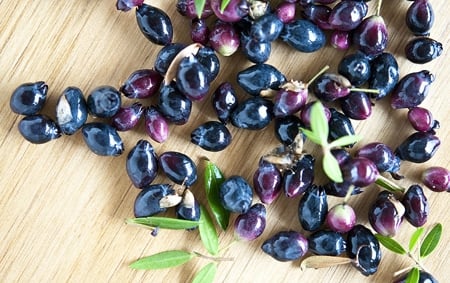
Myrtle is not the crape myrtle you may be thinking of. Myrtus Communis is “true” myrtle, and it is native to the Mediterranean. Mirto is made from its berries, and there is another drink called mirto bianco made from the flowers. Several years ago I tried to find myrtle — lots of Mediterranean recipes use myrtle’s aromatic leaves and twigs to flavor grilled meats — but had failed.
Apparently I didn’t look hard enough. No one at the nurseries I’d visited knew anything about a “myrtle bush” other than the crape myrtle. But when I thought to ask for Myrtus communis, they all said, “Oh yeah, we got that. It’s used for hedges.” Score! So I bought a bush. But by then the rains had stopped for the summer and, although I tried, my little myrtle bush died. Wah.
Then, one day, while I was at my friend Elise’s parent’s house, I noticed something. Something huge. “Holy shit! That’s a gigantic myrtle bush!” The myrtle bush alongside their house was 12 feet tall and easily 18 feet wide. And covered with blossoms. This bush wouldn’t die, and as I watched the blossoms turn into green berries, and the green berries turn into purple-black berries, I grew anxious.
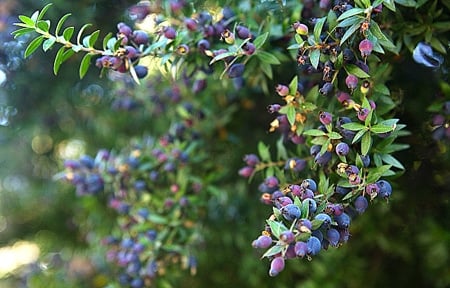
To make mirto, fill quart mason jars almost full with myrtle berries, then fill the jar with vodka — I like 100-proof because a) I am a well-known boozehound, and b) you get better extraction of an herb’s flavors with the higher alcohol content. Why not use Everclear? I suppose I could, but I’d like to drink this stuff eventually without going blind.
I’ll let my mirto steep for several months, then strain it and sweeten it with honey. It makes a wonderful after-dinner drink on cold winter nights.
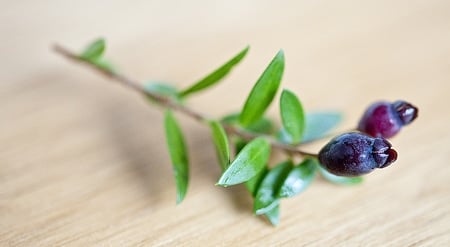

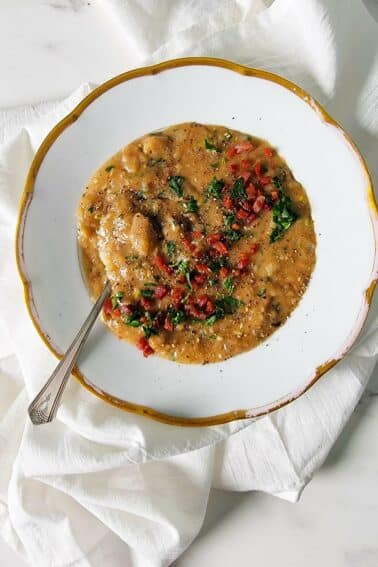

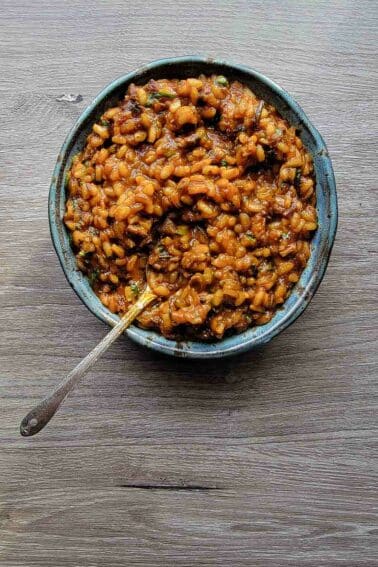
My italian friend tells me that it has to be kept in the freezer, which just thickens it rather than freezing solid – and it is drunk like that – extremely cold
I discovered Sardinian cooking and Mirto working for the US Navy in LaMaddalena a few years ago. Love them both, but a word of caution concerning the Mirto: Over-indulge and you will suffer a hang-over like no other.
I’m making my first batch of mirto and am curious: none of the recipes I’ve seen recommend pressing the juice from the berries upon straining. The berries look so plump and juicy this will be a great temptation. Is it because all the flavor has already been extracted and the skins and flesh won’t add anything or will make it cloudy (or perhaps will even detract)? Thanks for any information.
I discovered Mirto a few years ago, when a friend and I were in Milan. We both instantly fell in love with it.
Unfortunately, the Mirto available in the U.S. is not nearly as good. Possibly having to do with the required lower alcohol content.
I’ve been making my own alcohol drinks for some time now.
Having had planted close to 30ft of Myrtle, I noticed beautiful berries come in. Google pointed out they’re edible, so why not do something with them. I ground up about 8 cups of berries, took the mash and added some purified water. Boiled for about 15 min on low heat, and finally strained twice to remove all the pulp, sticks, twigs, etc.. This gave me 400ml of “juice”. Added 100ml by volume of sugar, and 250ml of POLISH SPIRITUS, 96% Grain Alcohol, made by Polmos. Everclear wreaks of corn and ruins the flavor; unless you’re making a whiskey-ish drink I highly recommend the Polish grain alcohol. This gave me a finished product of around 30% alcohol. After a week of sitting it had a nice bite, distinctive flavor, and nice conversation piece. It’s much more potent than just soaking the berries, but that adds to the flavor. Good luck and enjoy.
Thank you for all.the info. I absolutely enjoyed this. My.family and I lived in La Maddalena for a few years and miss the taste of everything Sardinia, especially the Vino. Can’t wait for the day we can return.
Interested in your article. I have a Myrtle bush which has flourished in Northern England. However this year we had a very serious frost and thought it had died. Fortunately, after a few months of apparent death, the shoots have started off again from ground level. I think we will have to wait a few more years to get berries again, which we have only had a couple of times. Still the flowers look great.
Hi there i live in sardinia where we make mirto every january.
Generally we use 100% proof alcohol avaliable here in the supermarkets as alcoool about 10 euro a bottle.
we steep the berries for 1-2 months, we make the syrup simply by melting sugar into warm water, and mixing about essence 50/50 syrup or essence 60/40 syrup
mix it when the syrup has cooled or you lose some of the alcohol.
have not tried using honey will give it a go and see what its like, good luck with yours!
I started some mirto on Friday! I am wondering if you can make a simple syrup and mix with some macerated myrtle berries, then add your vodka, and store in jars for a month or so. Rather than adding sweetener later. I have a cranberry cordial recipe that works that way. Any thoughts on that?
I have often wondered about the myrtle bushes here at work and what I could make with the berries. Looks like I will be doing some creative pruning tonight.
Hey Brant, I think your misunderstanding is pretty common. Based on Italian language suffixes, -illo means diminutive. So, mirto would be a regular size blueberry while mirtillo would be a smaller blueberry. However, they are 2 totally different plants.
Hank,
Funny thing is everyone I have ever enjoyed mirto with always explained it as a sardinian wild blueberry liquor, which I guess is just flat out wrong. will have to do some re-educating….
Use everclear without fear–just reduce the finished product with either a simple syrup or mix the honey with distilled water to bring the proof down to a safe level.
My experience making limoncello and other variations (amaretto, sambuca, vermouth and gin) is that the higher proof liquors draw off more flavoring as well as helping to give the final finished product a respectable kick. If you start at 100 proof the finished product is closer to 50-60 proof versus closer to 80 proof using everclear.
sante!
Brant
Casey: I’ll save some for you. It’ll be in my flask at the next BlogHer!
Kirsten: Love Vermentino, too! Look for myrtle bushes in landscaping. They don’t grow wild here, so far as I know.
Scott: I am totally buying that Calabrian cookbook! Love that part of Italy’s cooking. And you did ask nicely. I was just breaking your shoes…
Matt: Maybe she was Josh’s prom date? (See first comment)
Homegrown: I’ll get to it. I have several ideas, many involving quail…
Hank, sorry to be a beggar but any chance you might do a post about how to use the leaves, too?
Hey Hank! I was totally stoked when I saw this post. I don’t think I’ve ever told you that when I was in elementary school, we had a 17 year old girl from Sardinia live with my family as a foreign exchange student. I had recently reconnected with her and am planning a trip to visit her family in 2 years.
Anyway, I’d love to try your finished product sometime! Have fun!!
I thought I asked nicely……perhaps I should revisit my definition of “polite.” Effisio Harris’ book is lovely. I’m a huge fan of these super regional Italian cookbooks. I recently picked up a book about Sudtirol cuisine in the Dolomites. Another I can highly recommend is the soon to be released “My Calabria,” by Rosetta Costantino. Delightful!
This summer I also had the pleasure to discover mirto in both Sardinia and also the French version in Corsica. It is an incredible after dinner drink.
The agriturismos tend to make their own homemade versions which are thicker and much more flavorful than what you can get at the stores (they probably use more berries). One agriturismo even offered free lodging if you help with the berry gathering.
The myrtle bushes are pretty common in the countryside and the leaves really do add a very unique flavor to the meat dishes.
I’m in love with a Sardinian wine (a vermentino) so I leap at the chance of trying anything Sardinian. Thanks for posting! Now to find some myrtle bushes…
Is it possible to ship mirto across state lines? Or just save some for next October’s BlogHer? As a fellow boozehound, I feel it’s my necessity to taste this.
I went to my prom with the Sardinian foreign exchange student.